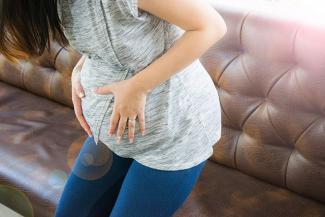
Porrselvi was very excited about her pregnancy and was looking forward to it. Strong and sharp abdominal pains in the third month of her pregnancy changed all of that. Find out what caused these pains (it affects more women than you would believe) and how she dealt with it.
The pregnancy glow, the much clichéd idea, was what I had in mind when I found out I was pregnant. I did not have much of a morning sickness, it was more of a motion sickness. So, naturally I was thrilled that my body was taking this whole new pregnancy experience in its stride. Then came the last month of the first trimester, when I started having strong lower abdominal pains, sometimes very sharp that I would have to bend over in pain, especially when I got up from the sleeping position or after passing stools. After my first trimester scan, the doctor told me there was nothing to worry and probably the pain will go away. Ha! Little did I know this pain would only grow in its severity over the next 7 months.
Symphysis Pubic Dysfunction
This pelvic pain has a name (thank you Google). Pregnancy related Symphysis Pubic Dysfunction has been reported in 31.7% of pregnant women and these numbers are increasing with rising awareness that such pain is not normal. SPD has been recognized as an obstetrical condition for a long time now in theory, until recently, there has been a lack of clinical or research interest. The disability related to symphysis pubis pain in pregnancy can vary from mild to severe but it is significant and any therapy that can help to reduce the discomfort is a welcome possibility. The rehabilitation therapy of this condition is complicated by the fact that many of the pain medications cannot be used by pregnant women and even if they can, pregnant women prefer to not take any drugs, lest they harm their foetus.
I fell under the second category but eventually in my third trimester when I could not bear the pain, I did take some prescribed pain killers which did not help me in any way.

Symptoms of SPD:
- “shooting” pain in the symphysis pubis;
- radiating pain into the lower abdomen, back, groin, perineum, thigh, and/or leg;
- pain on movement, especially walking, changing positions, unilateral weight bearing or hip abduction;
- pain with activities of daily living, including bending forward, standing on one leg, rising from a chair, going up or down stairs, turning in bed;
- pain relieved by rest (you can’t rest as you can’t turn in bed and often you will feel like you got locked inside your own body and cannot move at all, when such a paralysis simulation happens in the middle of the night, you panic and feel terror, atleast I did);
- clicking, snapping or grinding heard or felt within the symphysis pubis;
- painful sexual intercourse (if at all you are upto it during “pre-natal depression”- yes, women with SPD experience this, I did. As most often they are confined to their bed, can’t sit up (I could sit up only long enough to read the main newspaper everyday), read a book, watch a movie, or do any stitching etc.);
- occasional difficulty voiding;
- fatigue
The onset of pregnancy-related SPD varies, with 74% of women reporting it in a first pregnancy and 12% in the first trimester, 34% in the second trimester and 52% in the third trimester. Women who develop SPD during pregnancy generally have a good prognosis, as delivery is usually curative (Thank God, I was so happy I could walk again!). Most women’s pain regresses over the first 1–6 months post-partum, with 25% having pain 4 months post-partum and only a small number after 12 months.
Dealing with the pain
Exercise and targeted physical therapy have shown to help with the pain. I felt if I held the pubis symphysis (basically hold the area like you are holding back your pee) when walking, helped a little. I also felt there was an impaired sense of balance when I had the pain and so I had to be very careful, especially when walking down slopes (even ramps in the hospital). Even, travelling in the car became an ordeal, especially on Indian roads. Now, at 5 and a half months post-partum, I feel the only times I feel the pain again is when my car goes over bumps.
Reference:
Howell, E. R. (2012). Pregnancy-related symphysis pubis dysfunction management and postpartum rehabilitation: two case reports. The Journal of the Canadian Chiropractic Association, 56(2), 102–111. https://www.ncbi.nlm.nih.gov/pmc/articles/PMC3364059/






